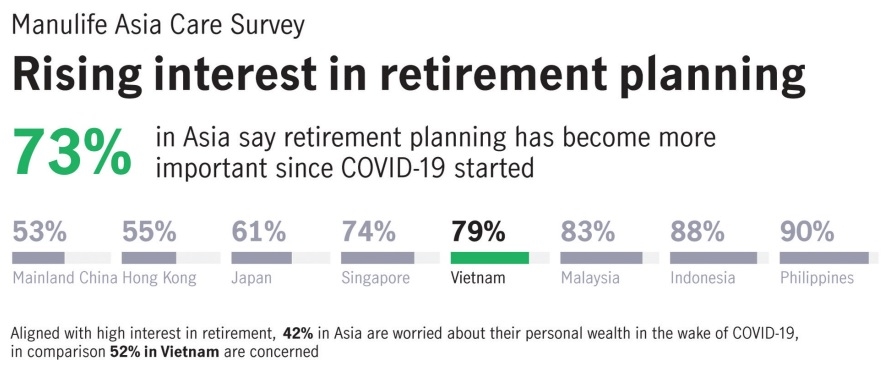Growth prospects fuel mutual fund appeal despite inflation pressures
 |
| Tran Thi Kim Cuong - CEO Manulife Investment Management Vietnam |
But there is a caveat. More than ever, when markets are turbulent or the interest rate cycle is set to turn upwards amid inflationary pressure – as is the case now – it is important to have a long-term investment strategy to ride over the market turbulence and effectively manage risk.
In Vietnam, where the asset management industry is relatively young compared to elsewhere in Asia, investor interest in mutual funds has grown significantly in recent years, buoyed by demand from a rapidly growing middle class looking for better investment returns.
In 2019, the asset and wealth management sector in Vietnam recorded strong 20-per-cent on-year growth to reach $13.4 billion – a tiny percentage of the $110 trillion global market, but it is a fast-growing one. It rose further in 2020 on the back of gains in the local stock market.
The Vietnamese stock market is important because people here are unable to invest outside the country due to foreign exchange controls. It means that investments by local asset managers and private investors go into the local market for which the VN-Index is the main measure of stock market performance, which has seen solid growth.
The fundamentals behind that growth have been positive too, with low interest rates incentivising investors. For them, the returns have been good, with the VN-Index rising almost 100 per cent from a 4-year low in March last year to an all-time high in early May this year. It proved to be among the top five global gainers in 2020.
Reinforcing the point, Moody’s Investors Service in March raised its outlook for Vietnam to positive from negative while reaffirming its Ba3 rating. Moody’s said the country stood to benefit from global shifts in production, trade, and consumption after the pandemic. The International Monetary Fund forecasts Vietnam’s economy to grow 6.5 per cent in 2021, up from 2.91 per cent in 2020.
Interest rates in Vietnam are typical of an emerging economy that is growing rapidly – more so than anywhere else in Asia last year. By current standards, they are high. However, the official refinancing rate is currently 4 per cent, down from 6 per cent at the start of last year. While remaining above average, the rate has in fact been on a downward trend for the past five years and is now at its lowest for more than 20 years.
The rate cuts last year by the State Bank of Vietnam were to support the economy in response to the pandemic, which was afforded by benign inflation. In fact, Vietnam’s rate of inflation was 2.8 per cent in 2019, down from 3.5 per cent a year earlier.
Inflationary pressures rising
But that is all changing. Inflationary pressure is building up. In fact, overall inflation in 2020 was 3.2 per cent, and is forecast to rise to 3.8 per cent this year and 4.0 per cent in 2022. With global supply-demand mismatch and prolonged monetary stimulus, commodity prices are rising, which would undoubtedly translate into inflation in Vietnam. According to Vietnam’s Price Statistics Department under the General Statistics Office, price pressures may quicken towards the end of the year amid higher oil prices and with domestic and global demand expected to increase.
With inflation will likely come higher interest rates. This will put short-term pressure on the market but will also create opportunities for investors as asset yields start to pick up and they are able to disburse their cash holdings into those assets.
It is a good reason to rethink the need to hold cash. At best, even very modest inflation will chip away at the value of cash. So, in times of higher inflation, it is best to invest spare cash elsewhere and hold only what is needed for day-to-day living expenses. As a rule, cash loses its value.
Vietnam is a young market. Its stock market launched in 2000, with its first asset management company established in 2003. Not long after, in 2005, Manulife Asset Management, now Manulife Investment Management, entered the Vietnamese market, becoming the first global asset management company in the market.
There are now nearly 50 asset management companies in Vietnam, most of them local ones, with only around 10 genuinely active. Up until about 10 years ago, the country only had closed end funds. That has changed, however, and since 2013 the market has opened up to open-ended mutual funds, enabling people to buy and sell as they wish.
However, government policy is still one of keeping US dollars in the country and invested domestically. That puts limits on what fund managers can offer, meaning that they must tailor their products accordingly.
Since the stock exchange launched, Vietnam has undergone a structural transformation that has largely lifted the country out of poverty. The number of people living below the lower middle-income poverty line of $3.2 a day has dropped from over 70 per cent to below 6 per cent. Vietnam now has a rapidly growing middle class that currently accounts for 13 per cent of the population and is expected to reach 26 per cent by 2026. Vietnam’s population with more than 55 per cent below the age of 35 is a demographic structure that many countries would love to have. The reality, however, is not quite so favourable, and Vietnam has a rapidly ageing population. For example, in 2015, there were 6.6 working-age adults for each person above 60 years; by 2055, that will have dropped to only 2.1 working-age adults per older person.
For many, the challenges ahead are understood. Appetite among individuals to take greater control of their financial planning has gone up, along with the levels of interest in mutual funds. It is a positive consequence of the economic transformation and the changing demographics. Taking control and action to build savings and accumulate wealth for the future – in particular, retirement – could not be more important than it is now.
 |
Pandemic ups the ante
It is a pressing issue that has been accelerated by the pandemic. In Manulife’s recent Asia Care Survey, conducted late last year and published in February, the findings showed that 52 per cent of Vietnamese are worried about their personal wealth in the wake of COVID-19, well above the regional average of 42 per cent.
Those financial worries have spilled over onto people looking at what sort of nest egg they have for retirement. Some 79 per cent of Vietnamese said that retirement planning has become more important to them since COVID-19 started. At the same time, 57 per cent of respondents looking to buy life insurance within six months of the fieldwork for the survey, higher than elsewhere in the region.
The survey findings demonstrated that, in Vietnam, there is very strong appetite for the right investment products.
Vietnam’s retirement protection gap is astronomical, running to hundreds of billions, possibly trillions, of dollars. The International Labour Organization estimated that about 83 per cent of all those above 60 did not receive a pension in 2017 – that is 8.3 million elderly people.
Notwithstanding traditional family support for elders, which is declining. It means that without significant action, including an expansion of the tax-funded scheme, 16.4 million elderly – or 79 per cent of the 20.7 million elderly above the statutory retirement age in 2030 – risk ending up without a pension. It is fair to say the government has its work cut out.
With its revision of the Law on Social Insurance, the government did reduce obstacles for participation in the state pension scheme. The Vietnamese Social Insurance agency contributions of 25 per cent a month are mandatory for formal workers in the private sector, while Vietnam’s millions of informal workers are entitled to contribute on a voluntary basis.
The problem is that many Vietnamese are uncertain what sort of state pension they will receive. There is little transparency on how the fund is performing. The risk of people running out of the money in retirement was a key driver behind the measures introduced in 2014. It also enabled asset management and life insurance companies to provide the voluntary pension funds to people to supplement their social insurance.
At Manulife, we have recently been working on an application to become Vietnam’s first global pension fund manager licensed to operate in the domestic market. It is hoped that the license application gets approval from the Ministry of Finance by sometime next year, if not sooner. Manulife’s competitors in the Vietnamese market are mostly local asset managers. Increasingly, they are either hiring foreign specialists or returnees from overseas, yet their point of difference from foreign companies, such as Manulife, is their greater acceptance of investment risk. They also tend to tilt towards a short-term approach to investment. We take a long-term view.
That long-term approach enables us to navigate inflationary environments more effectively. So, even now with inflationary pressures growing, it does not necessarily mean we have to stay away from investments. With a long-term strategy, we can find opportunities in short-term volatilities. In Vietnam, the growth prospect of the economy is so strong over the longer term that it can reward those who take a longer view in their investments.
Within that broader investment strategy, Manulife does offer various products offering different levels of risk. Some are more equities-based, others weighted more towards fixed income. Our challenge is to encourage more Vietnamese to move from a short-term view to planning for the long term.
Stocks and investment funds become more and more popular recently with a sharp increase in the number of new accounts opening as well as ample market liquidity.
Those less familiar with what is available from fund managers tend to put their savings in the bank. By doing that, they used to earn an interest rate of 7-8 per cent per annum. For many looking to avoid the headache of making more sophisticated investment decisions and using the supporting technology, this sort of return seemed sufficient. But with the current low interest rates, this approach now longer works.
Manulife Investment Management Vietnam has consistently delivered double-digit annualised returns, exceeding what’s possible from interest on cash deposits at the bank.
What the stars mean:
★ Poor ★ ★ Promising ★★★ Good ★★★★ Very good ★★★★★ Exceptional
Related Contents
Latest News
More News
- Double-digit GDP growth within reach with shift to higher-value expansion (January 06, 2026 | 08:33)
- Ho Chi Minh City projects $10.5 billion remittance inflows in 2025 (December 31, 2025 | 18:58)
- Digital shift reshaping Vietnam’s real estate brokerages (December 31, 2025 | 18:54)
- New decree sharpens enforcement in securities market (December 31, 2025 | 18:53)
- Voluntary Sustainability Standards pave way for Vietnam’s agricultural exports (December 31, 2025 | 09:00)
- Gold market reform advances as SBV receives applications for bullion production (December 30, 2025 | 12:07)
- Textile apparel firms deliver robust earnings despite global tariff pressures (December 30, 2025 | 10:09)
- Ho Chi Minh City hits $8.37 billion in FDI (December 29, 2025 | 08:28)
- Tax sector wraps up 2025 and sets priorities for next year (December 25, 2025 | 14:00)
- Heavy industries set for pilot greenhouse gas quotas (December 25, 2025 | 10:00)

 Tag:
Tag:




















 Mobile Version
Mobile Version